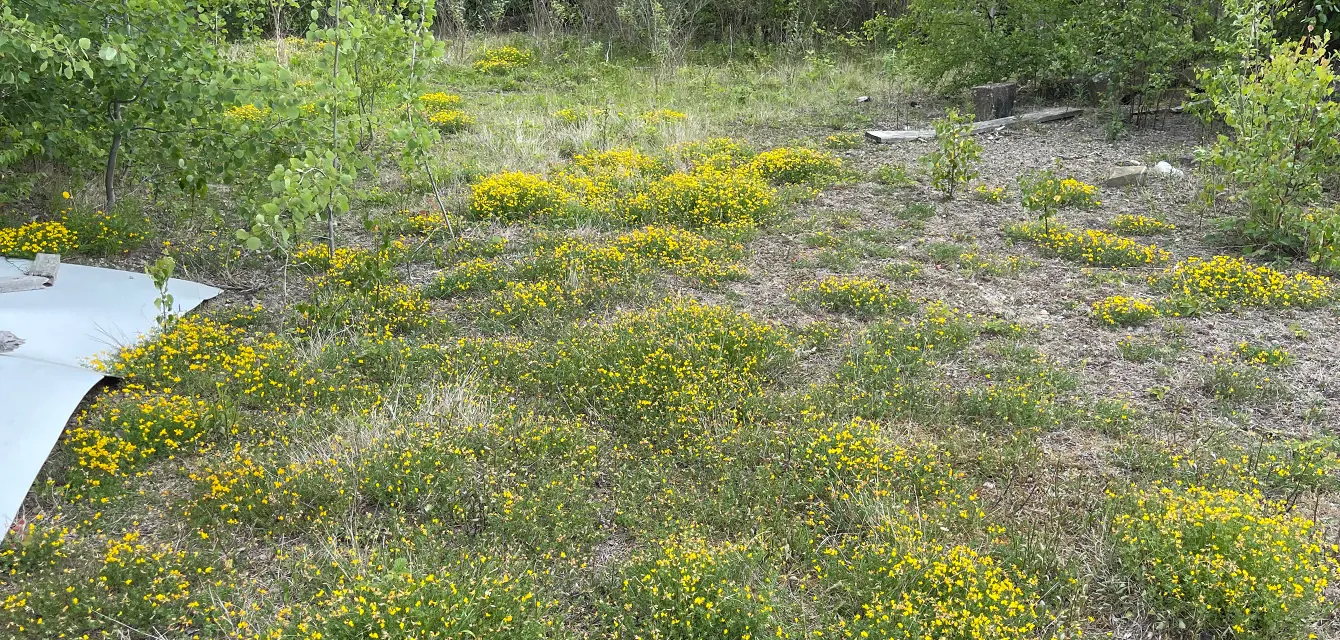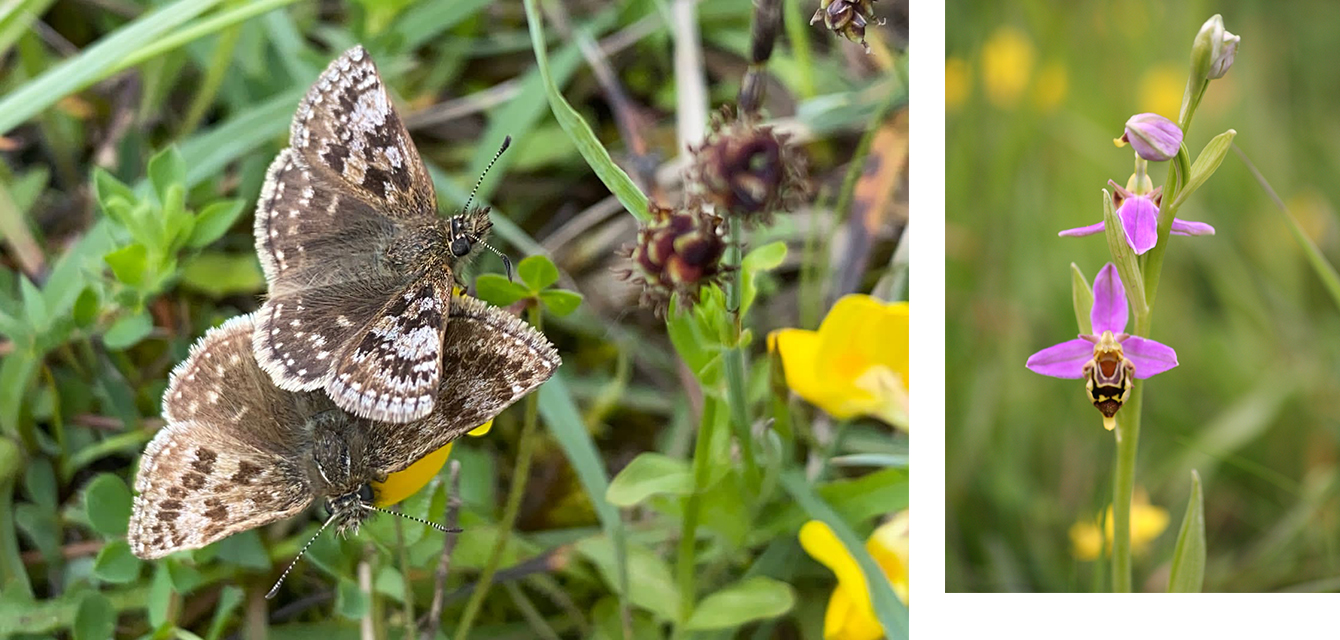Biodiversity Net Gain (BNG) is now a statutory requirement for most development in England, requiring at least a 10% increase in biodiversity value to the pre-development onsite habitat.
The introduction of BNG has brought much needed attention to the importance of the ecosystems within which we live and provides a statutory framework to ensure that new developments make a positive contribution to increase the biodiversity of the country.
Despite the very significant benefits that a statutory BNG framework brings, its initial introduction has raised some critical and concerning issues which remain subject to resolution. One such matter is how to compensate for losses in Open Mosaic Habitat.
For those unfamiliar with the terminology, ‘Mosaic Habitat’ is a classification for habitats which include several different typologies mixed amongst each other to form an ‘ecological mosaic’. For example this could be a mosaic consisting of a combination of grassland habitat with mixed scrub weaved throughout. ‘Open Mosaic Habitat’ (OMH) is a specific type of this classification, where the ‘mosaic’ is made from a mix of unvegetated (or sparsely covered) hardcore surface interspersed with areas that are more densely vegetated. It can be found across the country, and, crucially, is prevalent on brownfield sites where old roads, footpaths and building slabs have become fragmented and other habitats have naturally established; developing between and around the old infrastructure over the course of time.
OMH is recognised as a ‘High Distinctiveness’ habitat within the government’s statutory biodiversity metric. This means that these habitats have a high level of ecological importance.
Looking at OMH sites may leave those unfamiliar with them wondering why they are so important. At first glance, many are a far cry from the verdant glades and lush woodlands conjured to mind when thinking of ecologically rich habitats; they typically appear unkempt and are seen as an eyesore by visitors and nearby residents. It is however these attributes that make them so unique, with their brownfield foundation enabling this distinct habitat to form. The bare or sparsely vegetated patches provide a basis for the growth of certain types of plants which would otherwise struggle to compete against other species. This foundation when mixed amongst other habitats can also provide nesting, hunting, basking, foraging and egg-laying opportunities for insects and animals which also specialise in these conditions. Collectively these conditions can lead to the formation of highly valuable ecosystems.
It is important to note that not all brownfield sites contain OMH, although many of them do. To constitute OMH a habitat must meet specific criteria set out in the UK Habitat Classification – a specialist ecologist is required to reach this conclusion.
The introduction of a national net gain requirement has been helpful in highlighting how some of the most ecologically valuable habitats, such as OMH, are not necessarily the most obvious or aesthetically pleasing. This has provided a new framework of understanding for the environmental contribution of such habitats across the country. Over recent months however, the impact of the new statutory BNG requirements relating to OMH has highlighted a conflict between the very worthy principles of urban regeneration and the preservation and enhancement of OMH. This can, in no small part, be attributed to conflicting priorities from central government, namely:
-
An increasing emphasis that brownfield land should be prioritised for development
[1]; and
-
The statutory national requirement to preserve or replicate lost high distinctiveness habitats, in this case, OMH, which is typically found on brownfield land.
This clash of priorities is resulting in some very significant planning conflicts for those looking to redevelop brownfield sites which contain OMH. We have seen several examples where the following situation is playing out:
-
A developer is looking to bring forward a policy compliant development on an allocated brownfield site within a settlement;
-
The developer’s ecologist assesses the site and identifies OMH is present;
-
The developer is advised that OMH is a ‘High Distinctiveness’ habitat and is subject to the associated BNG requirements. This is not negotiable and is not subject to any viability considerations. They are advised that as a habitat of ‘High Distinctiveness’ any losses of OMH must be replaced with the same habitat type of the equivalent value (i.e. OMH lost to a development must be replaced with OMH);
-
In line with the government’s hierarchy for BNG provision, the developer considers whether any losses to OMH can be avoided, and if not, compensated for on their site in the first instance. Due to the unusual circumstances that lead to the formation of OMH, the developer’s ecologist concludes (in all cases we have experienced to date) that it is simply not possible to replicate OMH on site;
-
The developer then considers the next option in the BNG hierarchy - purchasing off-site units for the provision of off-site OMH habitat. However, as a result of the unusual conditions that lead to the formation of OMH there is a critical scarcity of sites that could deliver off-site mitigation. Off-setting OMH net gain requirements off-site is therefore not possible;
-
This leaves only one remaining option for the developer to achieve the required net gain - purchasing statutory credits through the government’s statutory credit scheme. Statutory biodiversity credit prices published by DEFRA earlier this year
[2] provide a cost of £48,000 per credit for OMH. As a statutory credit (rather than an identified off-setting scheme), there is then a ‘spatial risk multiplier’ which doubles the amount of credits needed; two statutory credits are required for one habitat unit, bringing the total cost
per OMH habitat unit lost to £96,000.
There are examples emerging across the country where the above situation is transpiring as an unintended consequence of the statutory BNG requirement. This is resulting in potential credit receipts in the millions for some developments, and can be significantly in excess of the total development cost (in some cases we have seen, the OMH credit cost alone has been nearly three times the total development cost). In such cases the cost of the statutory credits is clearly prohibitive and renders the development unviable.
To reiterate, the BNG requirement is statutory, non-negotiable and not subject to any tests of viability. In situations where developers are looking to redevelop brownfield sites with OMH, our experience to date is showing this is simply not possible in the vast majority of cases under the current system. This is resulting in towns and cities across the country with prime brownfield sites ready to deliver much needed new developments remaining undeveloped. Ironically, over time OMH develops into more mature habitats with a lower biodiversity value.
The situation is being further frustrated by the recent findings of a report commissioned by the Environment Audit Committee which assessed the progress Defra and Natural England had made in implementing BNG
[3]. This report found that there is not yet a mechanism to spend income from statutory credit sales to enhance biodiversity. So, even in instances where developers can afford to buy statutory OMH credits, this means they will be paying potentially very large sums of money that there is currently no mechanism for spending - ultimately meaning no benefit to biodiversity until this is resolved.
Whilst preserving and enhancing OMH is a crucial part of our biodiversity requirements, the nature of OMH, the locations in which it is found and the difficulties in protecting, re-providing or compensating for its loss bring it into direct conflict with the planning system’s other priority of redeveloping brownfield sites.
The current BNG legislation provides no scope for consideration of wider social and economic requirements, nor does it provide a suitable solution to enabling a net gain to OMH to be achieved on key regeneration sites.
Our BNG Solutions Group have been reviewing how this could be addressed. We are currently seeking to engage further with Natural England and Defra on a strategic solution which could include:
-
Councils identifying and managing key brownfield sites with the right conditions for creation of OMH habitat units; these could be designated as urban nature reserves which would be retained for the required 30 year period. Formally designating a select number of sites specifically for this purpose could offer a workable solution to the current impasse to bringing forward development on certain brownfield sites. Development on other brownfield sites could then come forward and achieve mandatory BNG through provision of funding to maintain and enhance the designated OMH sites. If well-managed and maintained these could form vibrant, ecologically rich assets meeting OMH requirements for cities and towns across the country. They could also offer potential wider funding opportunities for those areas with particularly high levels of OMH (essentially turning what is currently a constraint to regeneration into a significant environmental, economic and social benefit). This could be a joint endeavour between Councils and landowners through a Call for Sites exercise to identify appropriate sites as part of the Local Plan process and could include an agreed scheme of compensation for the landowner of the designated OMH – potentially from contributions from the redevelopment of other brownfield sites.
-
Potential partnership arrangements between Natural England and other key national infrastructure organisations to provide OMH. For example, this could be a partnership between Natural England and Network Rail to allow parts of Network Rail’s estate to be utilised for strategic OMH provision at a national level (such as through using areas adjacent to railway lines which are not accessible to the public and could be managed as OMH).
-
Provide increased support for urban areas with the highest proportions of brownfield sites and OMH to ensure wider regeneration requirements can still be achieved. This could include allowing alternative habitat creation in specific circumstances.
-
Allowing viability to be a consideration in specific circumstances where the regeneration needs of communities would otherwise be severely adversely affected as a result of OMH and the absence of an appropriate mechanism for off-setting. This exception would need to be very carefully crafted to ensure it achieved the desired balanced outcome without significant loss of an ecologically distinct and important habitat.
We are engaging with key organisations alongside our network of environmental specialists to seek to find an answer to this problem. We would welcome your own suggestions for how to resolve this conundrum.
If you are experiencing any issues with OMH or are considering developing a site which contains OMH then please do not hesitate to get in touch as we are collating national intelligence/experience to seek to agree how to unlock such sites.
[1] Banking on brownfield, Lichfields
[2] Statutory biodiversity credit prices, gov.uk
[3] Implementing statutory biodiversity net gain, National Audit Office




